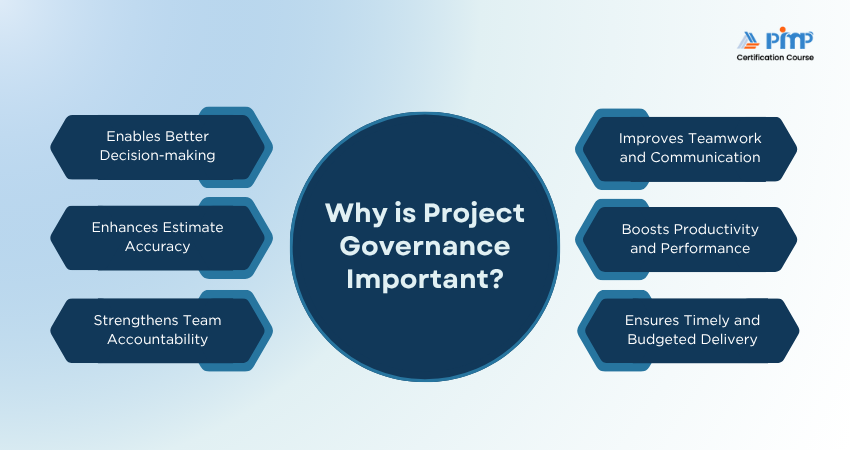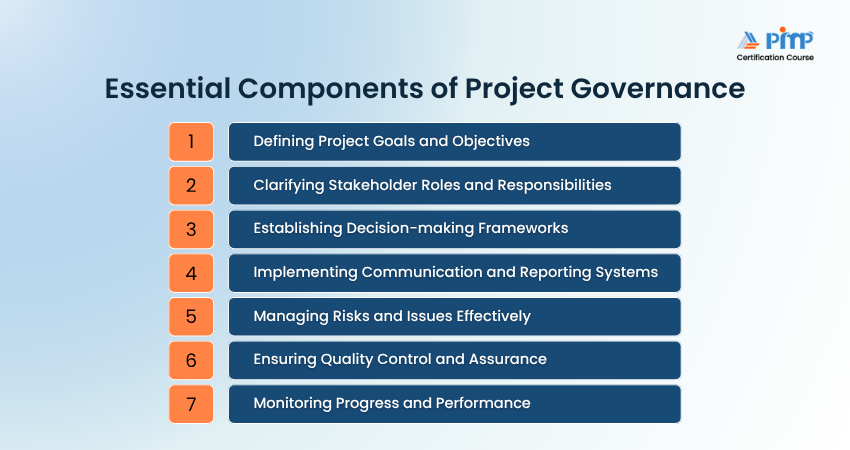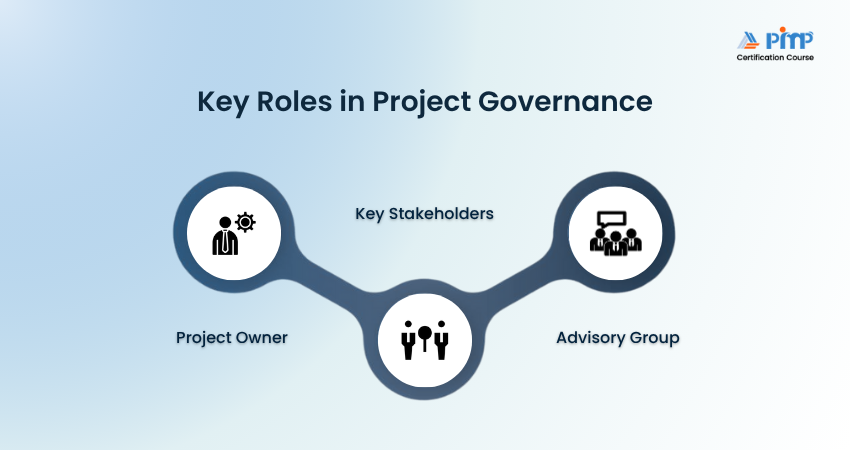







 10 Sep 2024
10 Sep 2024



Ever wondered why some projects succeed spectacularly while others fall apart despite the best intentions? The answer often lies in one powerful concept: Project Governance. It’s not just about having a plan or setting milestones. It’s about how decisions are made, how responsibilities are shared, and how performance is tracked throughout the project lifecycle.
With growing complexity in project management and rising stakeholder expectations, the need for robust governance is more critical than ever. This blog takes a deep dive into what Project Governance truly means, why it matters, and how to build a framework that keeps your projects aligned, controlled, and on course.
Table of Contents
1) Understanding Project Governance
2) Why is Project Governance Important?
3) Essential Components of Project Governance
4) The Three Core Pillars of Project Governance
5) Key Roles in Project Governance
6) Advantages of Strong Project Governance
7) Common Challenges in Implementing Project Governance
8) Conclusion
Project Governance is the structure of guidelines, policies, and procedures guiding, controlling, and supervising project activity. It ensures that projects are carried out in a methodical, consistent, strategic way that fits company objectives.
Fundamentally, Project Governance defines responsibility and decision-making power all around a project. It entails establishing precise roles and responsibilities, building decision gates, and making sure every stakeholder understands who is in charge of what and when.
While daily activities are the main emphasis of project management, Project Governance offers the strategic control and direction required to ensure success. It ties company strategy to project execution.

Strong governance ensures that projects are delivered successfully, not just in terms of delivery but also in alignment with broader business goals. Here's how:

With a structured governance framework, decisions are not made in isolation. Every decision is backed by clear criteria, risk assessments, and stakeholder input. This reduces ambiguity and ensures alignment with the project’s strategic intent.
Project Governance introduces decision gates, which are checkpoints to validate project progress. These gates prevent costly rework and help steer the project in the right direction at every stage.
Accurate forecasting is critical to managing timelines, budgets, and resources. Project Governance establishes mechanisms for reviewing estimates regularly and comparing them with actual performance.
By ensuring transparency in how estimates are made and adjusted, governance allows stakeholders to make informed trade-offs and course corrections when needed. This builds trust and improves predictability.
Clear governance defines who is accountable for each component of the project. It ensures that there is no duplication of roles or gaps in responsibility.
With defined escalation paths and reporting structures, teams are more likely to stay focused and committed. This improves individual and group accountability, helping teams function more effectively under pressure.
Project Governance promotes open communication across roles and functions. Usually, governance systems have a communication plan including flow of information and frequency of reporting. Improved communication systems help to reduce misunderstandings and enable teams to work with more cohesiveness and clarity.
Strong governance eliminates obstacles by means of rapid decisions and issue resolution. Work goes more naturally when everyone is aware of the escalation processes and the chain of command. Moreover, governance ensures methodical tracking of performance. Regular monitoring of metrics and KPIs helps to identify underperformance early and facilitates faster recovery efforts.
A well-run project has a higher chance of finishing under budget and on schedule. Monitoring scope, risks, and quality at all phases helps governments prevent scope creep, cost overruns, and delivery delays. This not only saves money but also protects the project team's and the organization's general reputation.
Advance your leadership skills with our globally recognized PMP Training - Sign up now!

To build a strong governance model, the following components are essential:
Every project starts with a purpose. Governance ensures that the project’s goals are clearly defined and tied to the organization's strategy. This includes outlining success criteria, measurable outcomes, and key milestones. Clear goals ensure that all stakeholders share the same vision and expectations from the start.
From project sponsors to team leaders and outside suppliers, governance gives stakeholders certain duties. Every position carries a clear set of duties and authority levels. This clarifies uncertainty, lessens disputes, and improves teamwork by ensuring everyone understands the expectations.
Projects can have tough decisions involving scope adjustments, extra funding, or acceptance of delays. A governance model clarifies who makes what decisions and how those decisions are evaluated. This ensures that critical issues are addressed openly and fast, preventing decision paralysis.
The success of a project depends on communication. Governance systems standardize daily stand-ups, weekly reports, monthly stakeholder meetings, and communication channels to ensure an efficient flow of data. Dashboards, KPIs, and automatic alerts are often part of reporting systems that provide real-time insight into project conditions.
Governance promotes a proactive approach to risk management. It includes a structured process for identifying, analyzing, and mitigating risks throughout the project lifecycle. It also includes an issue management plan to resolve roadblocks quickly, minimizing the impact on delivery timelines and team morale.
Governance defines the quality standards that a project must meet and the procedures to measure compliance. Quality gates and review cycles are built into the delivery schedule to catch issues early. This ensures that the final output meets functional requirements and also adheres to compliance and customer expectations.
Performance monitoring is vital for tracking delivery against the plan. Governance models use KPIs, dashboards, and performance reviews to keep everything on track. This enables continuous improvement by highlighting areas of strength and identifying processes that need optimization.
Master agile frameworks with our PMI-ACP Course now.
Here following are the Three Core Pillars of Project Governance:
This refers to the formal structure within which projects operate, including steering committees, governance boards, and reporting hierarchies. The structure defines who controls what, who reports to whom, and how oversight is maintained. It creates a clear chain of command and ensures that project managers have access to guidance and decision support from senior leadership.
People are at the heart of governance. It’s not just about assigning roles but about empowering individuals with the authority and tools to fulfil their responsibilities. Governance ensures proper resource allocation, skill development, and stakeholder engagement, allowing people to perform effectively within their roles.
Informed decision-making depends on accurate, timely, and accessible data. This pillar includes all the project information, progress reports, financials, risks, and quality metrics that stakeholders need to stay aligned. Governance ensures that the right data reaches the right people at the right time.
Effective governance involves multiple roles working in harmony:

The project owner is typically a senior executive or sponsor who champions the project. They are accountable for aligning the project with business objectives, securing funding, and making high-level decisions. They also act as a bridge between the project team and senior stakeholders.
Stakeholders include everyone impacted by or contributing to the project. Governance identifies these individuals early on and outlines how they will be engaged throughout the project lifecycle. Their input is crucial for requirement gathering, risk assessment, and validating deliverables.
This group provides expert advice and guidance on complex or high-risk issues. It may include technical experts, legal advisors, or representatives from regulatory bodies. They help ensure that the project complies with internal policies and external regulations.
Build expert-level Business Analysis skills with our PMI-PBA Training - Sign up today!
Investing in Project Governance pays off in numerous ways:
Governance keeps projects aligned with organizational strategy by continuously evaluating whether the objectives and outcomes are on track. This prevents resource waste and keeps leadership engaged.
When stakeholders are kept informed and their concerns addressed promptly, their satisfaction improves. Governance ensures transparent communication, consistent updates, and fair resolution of issues.
A structured governance model identifies and mitigates risks early, reducing the chances of costly surprises. It also prepares teams to handle uncertainties with agility and confidence.
With clearly defined authority levels and data-backed reporting, decisions can be made faster and with greater clarity. This accelerates delivery and improves outcomes.
Accountability is embedded in governance structures. With everyone knowing their role and being monitored for performance, there's a greater sense of ownership and responsibility across the team.
Lead large-scale programs effectively with our PgMP Certification.
Despite its benefits, Project Governance is not always easy to implement. Common challenges include:
1) Resistance to Change: Teams may see governance as bureaucratic or restrictive.
2) Lack of Clarity: Vague roles or conflicting responsibilities can lead to confusion.
3) Insufficient Training: Governance demands new skills and mindsets that not all team members possess.
4) Poor Stakeholder Engagement: If stakeholders aren’t involved early, decisions may lack support or alignment.
5) Over-engineering the Process: Excessive controls can slow down decision-making and demotivate teams.
Overcoming these challenges requires a balance between structure and flexibility and a culture that values transparency, learning, and collaboration.
Project Governance is not a luxury; it’s a necessity. It gives projects a strategic compass, a control mechanism, and a collaborative environment that increases the odds of success. From assigning roles to enabling smart decisions, governance is the engine that drives project performance. A well-structured governance model is the key to delivering value consistently and confidently.
Start your project career with our certified CAPM Training - Register today!






© Copyright 2025. All rights reserved. Contact: PMP® TRAINING ACADEMY.


